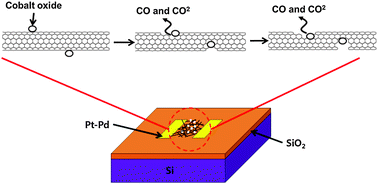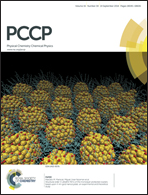Electrical percolation characteristics of metallic single-walled carbon nanotube networks by vacancy evolution†
Abstract
In the present study, we demonstrate the effect of vacancy evolution on high-pure metallic single-walled carbon nanotube (m-SWCNT) networks by observing the electrical characteristics of the networks on the field-effect transistor (FET). By catalytic oxidation using Co catalyst, vacancy evolution was gradually realized in high-pure m-SWCNT formed as networks between source-drain electrodes of FET. The evolution of vacancy defects in the m-SWCNT networks gradually proceeded by heating FET several times at 250 °C in air. Atomic force microscopic images showed the presence of the Co catalyst nanoparticles, which were evenly formed in the m-SWCNT networks between the electrodes of FET. Vacancy evolution was confirmed by monitoring the D- and G-bands in the Raman spectra measured from the networks after every step of the catalytic oxidation. With vacancy evolution in the networks, the D-band gradually increased, and the transconductance of m-SWCNT networks drastically decreased. In addition, the metallic behaviour of the m-SWCNT networks was converted into a semiconducting one with an on/off ratio of 2.7.


 Please wait while we load your content...
Please wait while we load your content...